 This time, we’re going to analyze the Academy award-winning costume designs of “Bram Stoker's Dracula”. The stage costumes of this film are interesting because the designer Eiko Ishioka had no experience for such a job and played a little bit with historical accuracy. Though, the clothing of Dracula’s characters is charming and eye-catching. They really deserve our consideration. But let’s begin. In this part, we’ll take a closer look at the stage costumes of Dracula and his beloved Elisabeta / Mina.
This time, we’re going to analyze the Academy award-winning costume designs of “Bram Stoker's Dracula”. The stage costumes of this film are interesting because the designer Eiko Ishioka had no experience for such a job and played a little bit with historical accuracy. Though, the clothing of Dracula’s characters is charming and eye-catching. They really deserve our consideration. But let’s begin. In this part, we’ll take a closer look at the stage costumes of Dracula and his beloved Elisabeta / Mina.
This material is based on the video from YouTube channel “Costume CO”.
“Bram Stoker's Dracula” is a 1992 American romantic horror film, directed and produced by Francis Ford Coppola, based on the novel “Dracula” by Bram Stoker. The cinematic telling of the story begins in an epilogue that’s set in 1462 Transylvania and flashes forward 4 centuries to 1897 Transylvania, London, and Budapest.
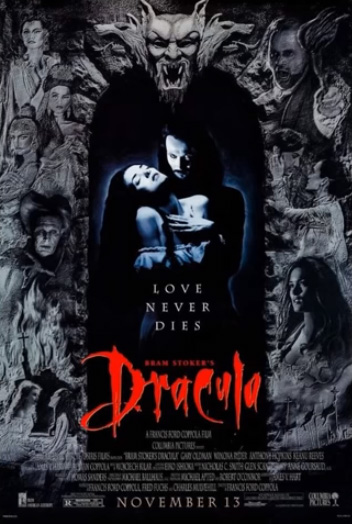
Having worked with a Japanese graphic designer Eiko Ishioka on past projects and trusting in her talents, Coppola hired her as costume designer. Not only had Eiko never worked as costume designer before, but she's never seen a vampire film before she got the job.
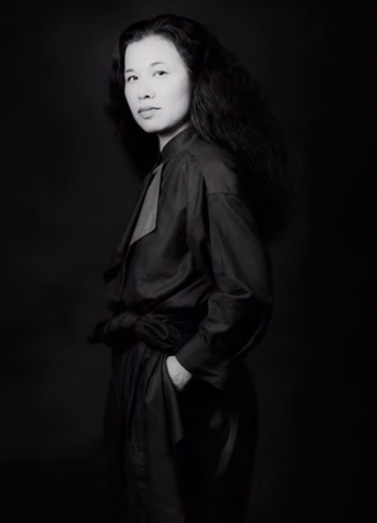
Having no experience as a costume designer meant that Eiko was not limited to the creation because she had no preconceptions about what the costume construction entailed – something that might have held back an experienced costume designer in the same position.
Also, Eiko wasn't restrained by the film's period, casting a wide net on the 19th-century historical setting and, at times, completely abandoning historical accuracy.
Eiko and Coppola drew upon symbolism and themes, including inspiration by late 19th-century and early 20th-century artists from the Neoclassical, Pre-Raphaelite, and Art Nouveau movements. One of their most profound influences was painter Gustav Klimt. On the left, this is a 1907 painting of Adele Bloch-Bauer from his “Golden Phase” and on the right, this is a portrait of his muse Emilie Floege from 1902.
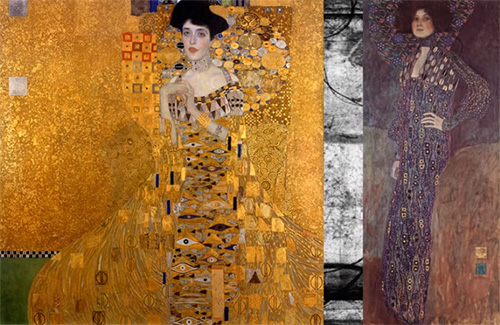
Like Eiko, Klimt was influenced by Japanese art and its methods.
The design was also influenced by Byzantine mosaic artworks and architecture of the Eastern Roman Empire, the time period is prior to the Ottoman Empire when Dracula's origin story begins.
Here are three 12th-century mosaic portraits of emperor Jean II, Empress Eirene, and their son Alexios from panels of the Hagia Sophia in Turkey.
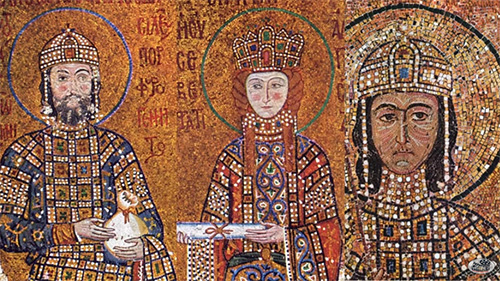
Eiko’s own design illustrations are borrowed from the Art Nouveau style of Czech artist Alphonse Mucha. Like in this painting of Mucha’s own daughter from the 1920s. The lithograph on the right is from 1897.
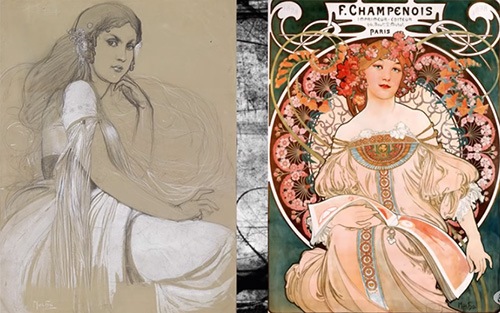
Stoker based his fictional Dracula after the Prince of Wallachia and the second son of Vlad Dracul. Vlad III or Vlad the Impaler, pictured here in an Austrian painting from about 1560, was a Draconis or a member of the Order of Dragons. The word “dracul” translates from Romanian as the “dragon”.
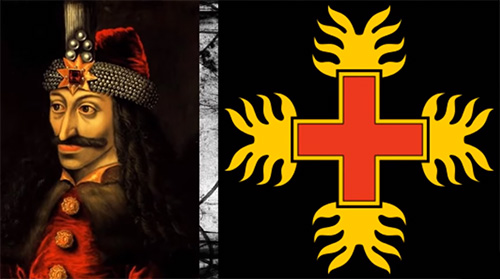
Pictured on the right, is the symbol of the Order of the Dragon. The order adopted st. George as its patron saint, whose legendary defeat of a dragon was used as a symbol for the military and religious ethos of the order.
Here is an embroidered Order of the Dragon emblem just after 1408. Note that the Christian cross is incorporated into the symbol.
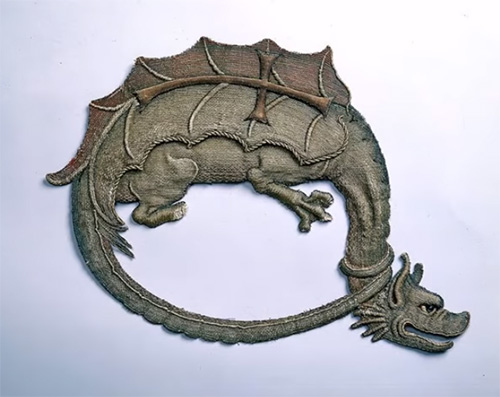
In the top image, we see the ceremonial sword from the Order of the Dragon on display at the Vienna Collection of Arms and Armor in the Neue Burg Museum in Austria. The sword dates from 1433 and features a gilded cross piece and ivory hilt. Below, here is a replica of Vlad Dracula’s sword from the movie “Bram Stoker's Dracula”.
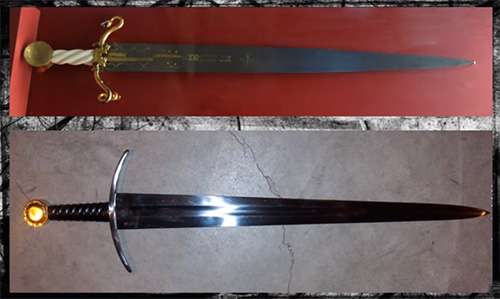
Costumes of Dracula
Actor Gary Oldman had at least a dozen costumes. Determined to modernize the main character, Eiko transformed one of the story’s most familiar tropes – she banished the expected cape and instead dressed Oldman in a crimson red robe that billows behind him as he prowls about the castle.
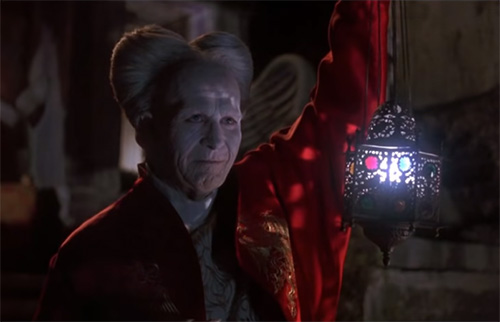
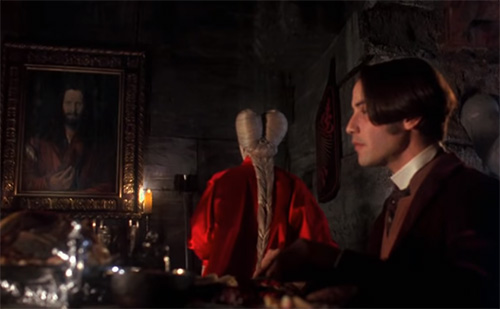
Eiko’s take on old Dracula's robe was influenced by the Chinese emperors Yuan, Ming, and Qing. After the Han Dynasty 18 centuries ago, the dragon became the symbol of imperial power and represented the emperor, the embroidery feature prominently on the emperor's robes.
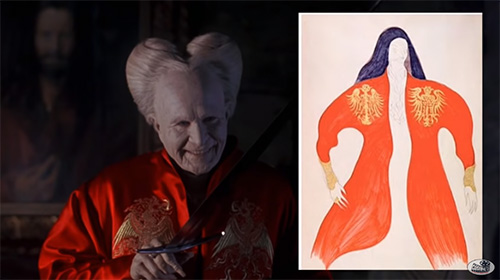
The Ming Dynasty ruled China from 1368 to 1644. Clothes belonging to Confucius aristocratic descendants are among the best preserves of the era. This red robe from the Ming Dynasty is a wonderfully preserved example.
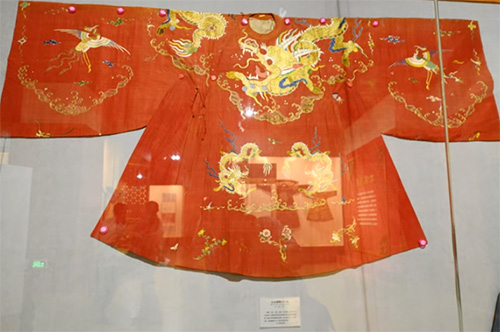
The elaborate gold and red embroidery on Dracula's robes appears to be a hybrid of two supernatural spirits – the Dragon and the Phoenix (which is a mythological bird).
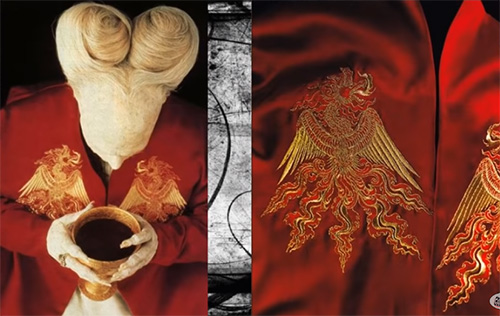
According to Fengshui, the dragon and the phoenix are the ideal couple. Dracula represents the dragon or masculine “yang”, while Elisabeta or Mina represents the phoenix or feminine “yin”, creating a yin-yang balance. This symbol is also a close representation of the embroidery from Elisabeta's gown.
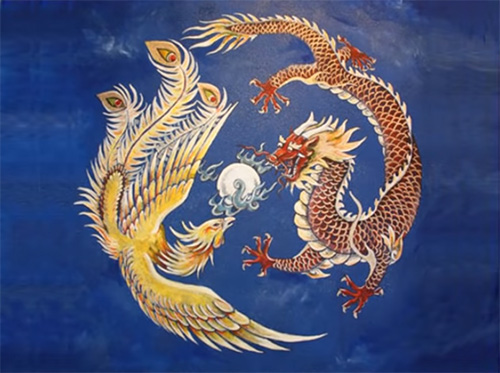
The master wig maker Stewart Artingstall built Gary Oldman's wig based upon Oscar-winning hair and makeup designer Michelle Burke's design.
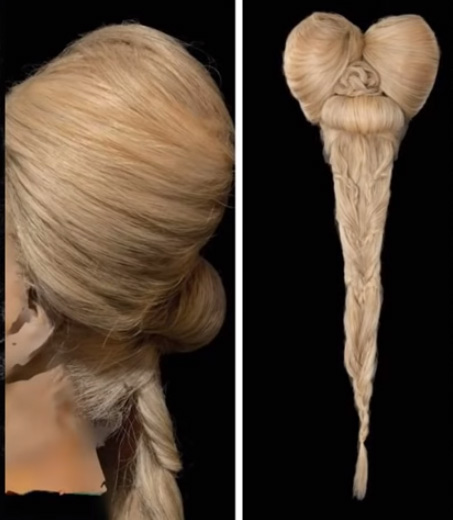
Every wig took many hours of painstaking work to hand-thread each hair into place individually.
Of the two-bun wig, Burke says in an interview, “I looked at designs of Hopi Indians and I went back to old kabuki. This was a marriage between East and West”.
Dracula's coffin costume is one of Eiko’s most striking costumes.
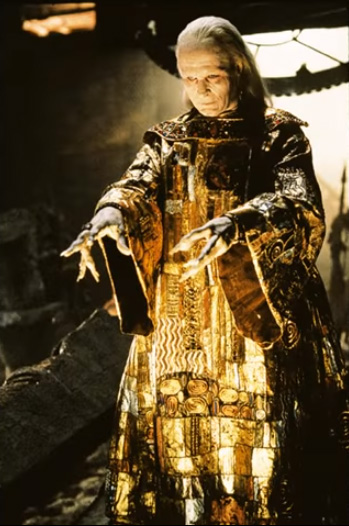
Eiko’s design for the kabuki-style costume on the left and the final costume from an exhibit on the right is a mixture of gold, bronze, copper, and other metallics.
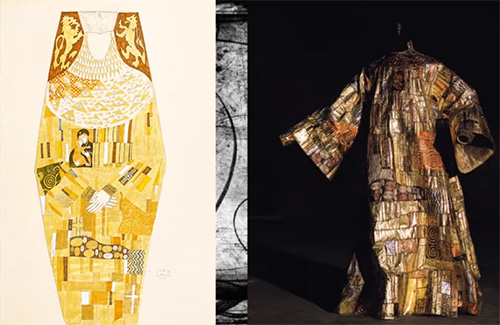
Each section of fabric was hand-placed on the robe and collar during a fitting process and combined like a patchwork quilt.
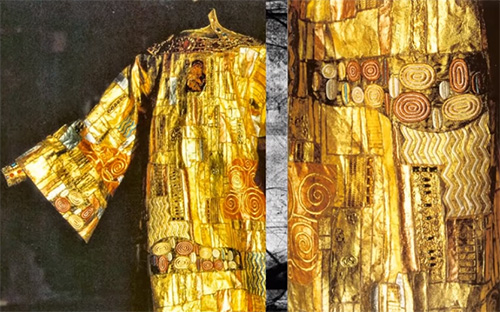
The costume is inspired by Gustav Klimt’s “The Kiss”. Eiko said, “When I saw the painting, I could feel the very Oriental flavor with Western painting. I wanted to express hybrid culture – East meeting West”.
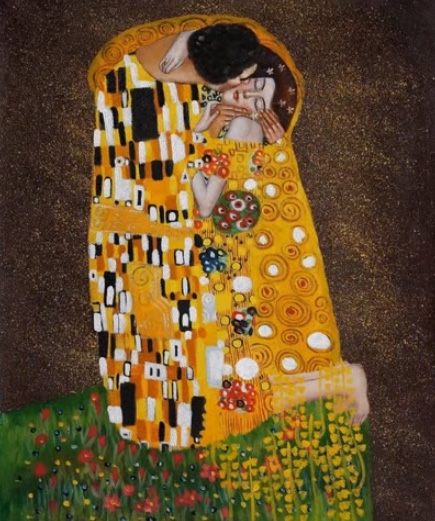
Being 400 years old, here young Dracula is trying to fit into modern-day life in London. But he still comes off as somewhat out of place.
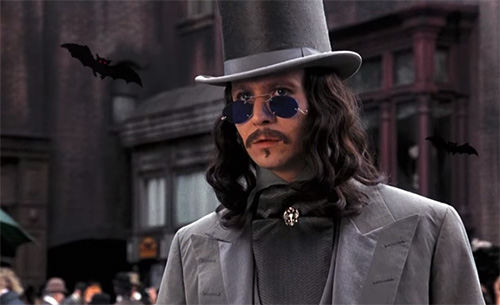
This late-in-the-century morning coat or sack suit replaced the frock coat for young men, and his long hair seems to be dated.
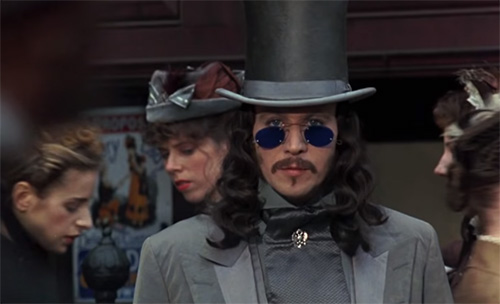
His ensemble is completely gray, including his wingtip shirt, top hat, cravat, and leather gloves. Dracula looks otherworldly with the sapphire-blue pinched-nose spectacles.
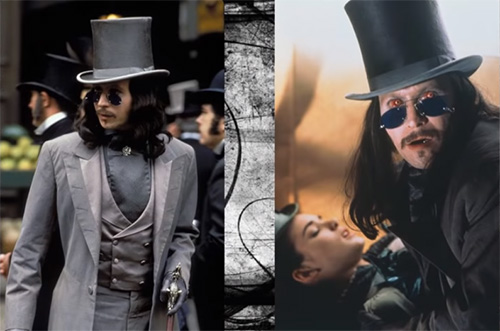
Here are the actual gray felt top hat, worn by Gary Oldman and his walking stick from the film. The walking stick features an elaborate silver-metal winged dragon head and a wooden shaft with aluminum tip.
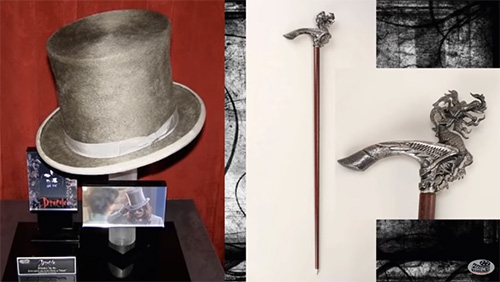
Here is another look for Oldman from a brief scene. It's difficult to tell with the backlighting but it looks like his black overcoat has overly long slouchy sleeves. He carries the same walking stick.
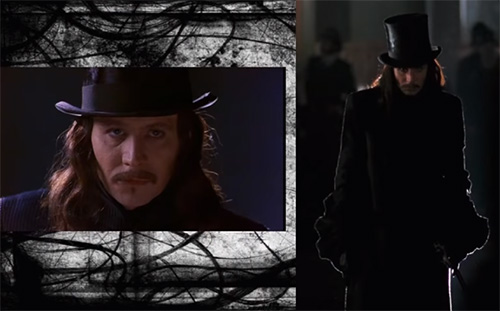
In this scene, Dracula wears a military-style coat with decorative metallic gold leaf embroidery on the jacket front and on the cuffs.
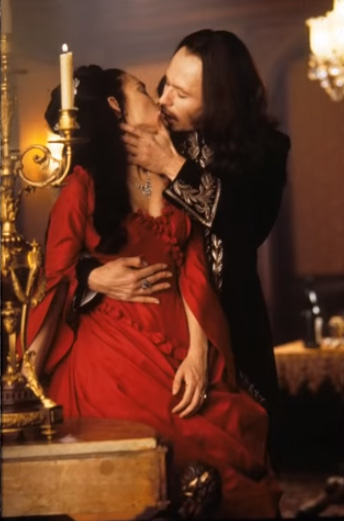
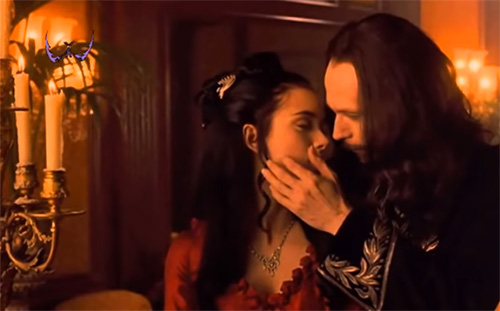
Dracula's outfit looks similar to this 20th-century British military uniform on exhibit at the V&A in London.
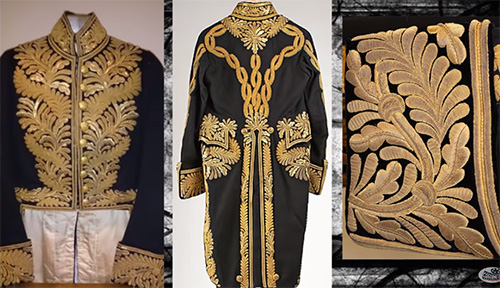
Poor Dracula waits for Mina dressed in this cream tail suit and bow-tie cravat before he discovers that she has stood him up at the cafe.
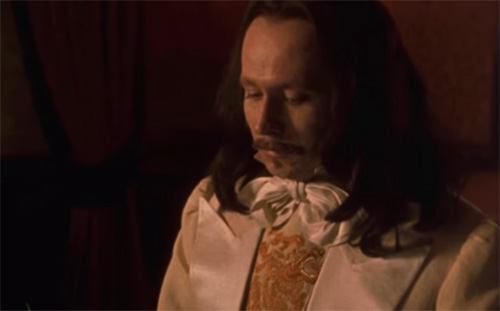
Here is a close-up detail of the vest embroidered in a golden and metallic-gold dragon motif.
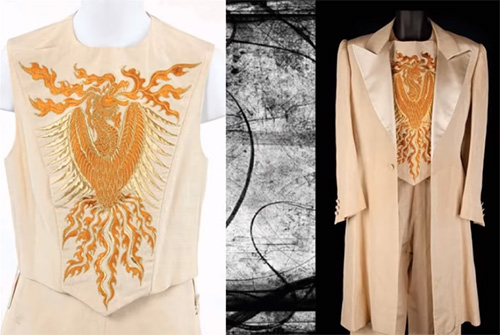
Notice the similar design to the crest on Elisabeta's gown, which we will look at later.
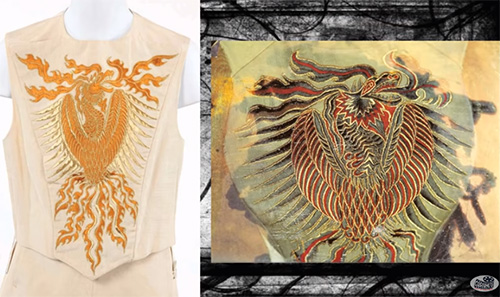
Costumes of Elisabeta / Wilhelmina “Mina” Murray
In a flashback segment, we meet Dracula's beloved wife Elisabeta played by actor Winona Ryder. This medieval green brocade gown, seen here on exhibit, is heavily embroidered with a gold leaf motif on the gathered and tapered sleeves and full skirt with cartridge pleats – a 15th and 16th-century method of gathering large amounts of fabric to a small waistband. Note that on the right, the gown is stained with fake blood from Elisabeta's death scene.
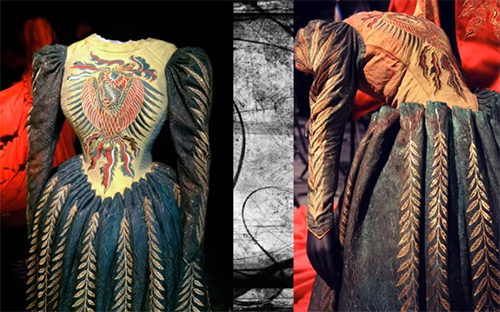
In a close-up, we see that the front panel of the bodice is embroidered with a dragon motif in bright-colored red, green, and gold metallic floss.
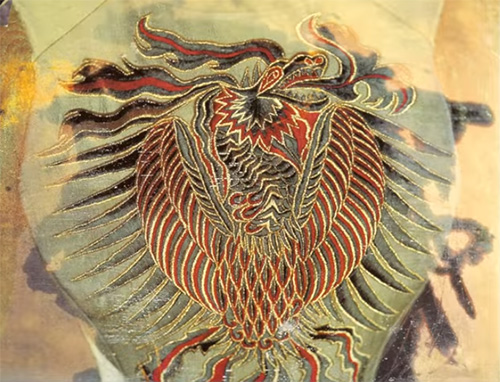
Ryder wears a warm-gold acanthus motif tiara that complements the metallic royal fern embroidery on her gown.
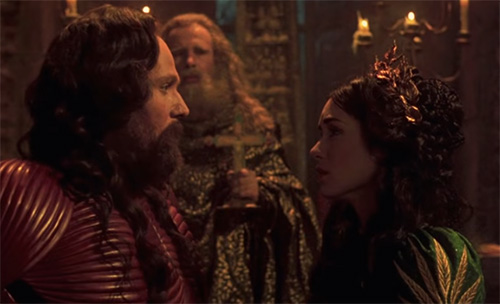
The royal fern (also referred to as the “flowering fern”) is a magic flower in Slavic mythology that represents fertility and sexuality.
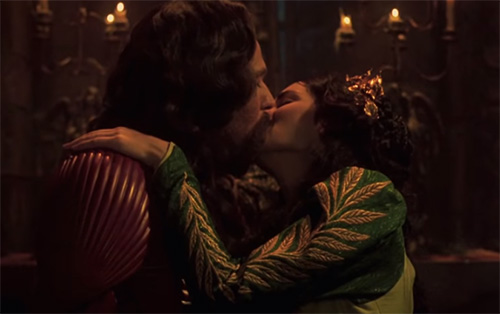
Acanthus and other leaf motifs were a popular ornament used in Greek, Roman, and Byzantine art and architecture. This Greek gold wreath is from the 2nd century B.C.
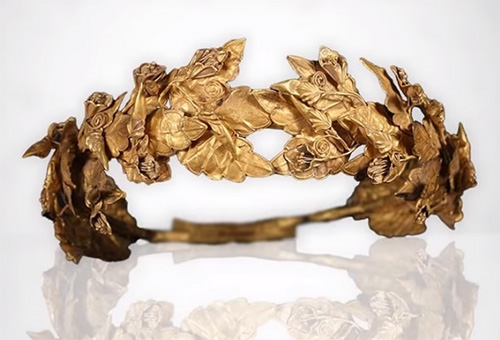
The character of Mina Murray, also played by Winona Ryder, is a middle-class teacher.
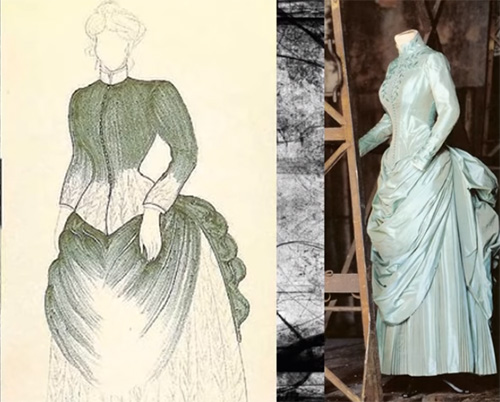
Eiko explains that Mina's gowns are tight, high-neck, and conservative, both virginal and modest. Like for this look we first see Mina in.
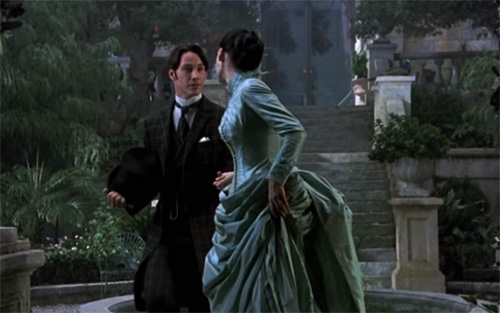
Mina's gown’s bodice and a Mandarin collar feature folk art style leaf motifs – most likely rosemary leaves which symbolize love and fidelity or death, loss, and grief. The seafoam green color of the gown represents Mina's purity.
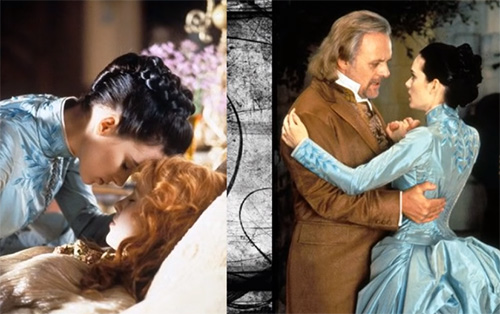
Here are two silk bustle gowns from the Victorian period, similar to the cut and drape of Lucy's gowns. The sage green visiting gown on the left dates from the early 1880s, while the leaf green gown on the right is from about 1886.
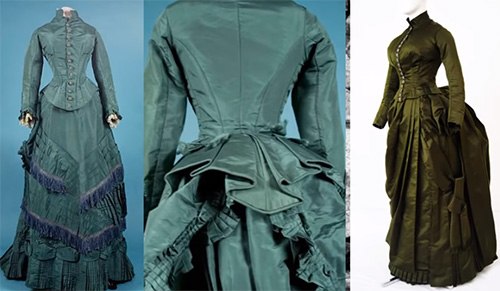
Mina's soft silk and faintly patterned gown is more in keeping with aesthetic fashions of the era. The unstructured aesthetic style was cut looser in the style of medieval or Renaissance garments with larger sleeves. It was an extreme contrast to the mainstream fashion of the period that included tight corsets, hoop skirts, and bustles.
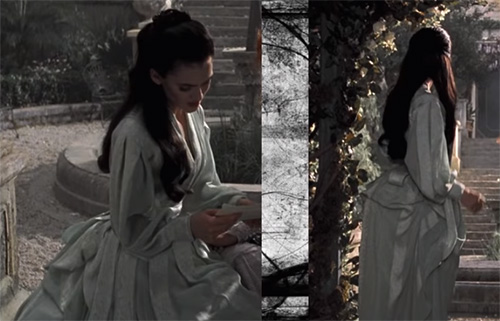
Everyday dress was sometimes adopted from Pre-Raphaelite paintings, like “The Day Dream” by British artist and poet Dante Gabriel Rossetti from 1880. On the right, is a Liberty of London, aesthetic-style plain silk-weave gown from 1910.
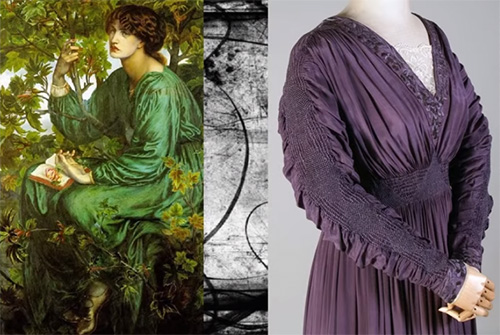
Mina's gowns were meant to be a stark contrast to Lucy's more erotic costumes. Mina's gown, seen here, is constructed from soft green silk with a cream silk organza overlay, again with an embroidered leaf motif.
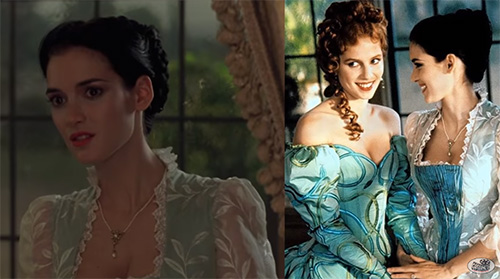
Here's a Hungarian velvet gown from the early 20th century in an almost identical color to Mina's gown, embroidered with gold metal thread and taffeta sleeves.
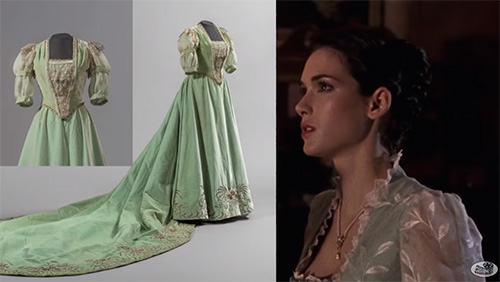
And another green outfit Eiko created, this two-piece walking suit for Mina's first encounter with young Dracula. It is constructed from silk taffeta, the contrasting lapels, collar, and cuffs are embroidered again with a leaf motif.
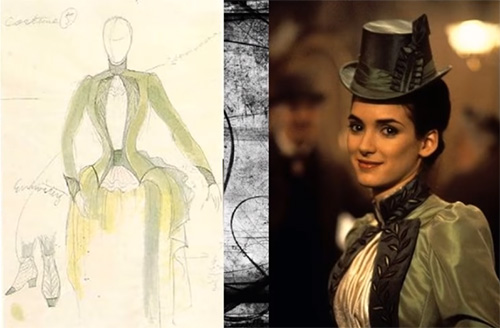
Her accessories include green gloves and a matching lady’s silk taffeta topper.
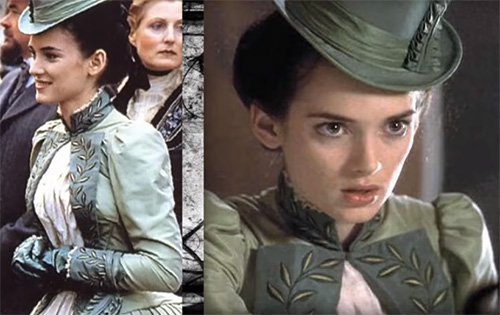
Here are some ladies hats from the era. The straw hat on the left on exhibit from The Metropolitan Museum of Art dates between 1884-86. And on the right, is a beautiful illustration of a Victorian hat from a French magazine.
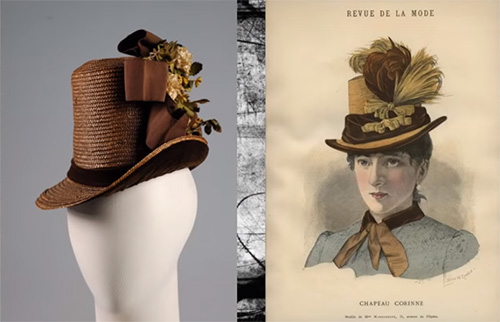
Realizing that she is the reincarnation of Dracula's beloved Elisabeta, Eiko takes a dramatic turn on Mina's conservative and restrictive clothing and muted color palette. Mina's red bustle gown features an open neckline and three-quarter length sleeves with romantic open cuffs.
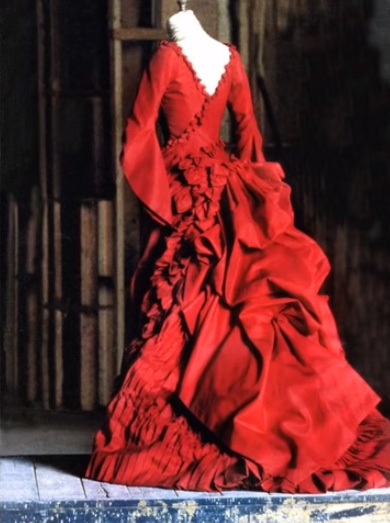
In an interview, Eiko says that “Dracula has this dress specially made for Mina, the object of his passionate love. It suggests that Mina will soon turn into a vampire”.
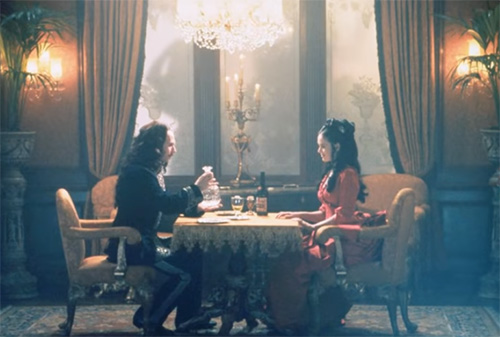
The deep silk gown is in three sections from what we can tell – the asymmetrical bodice, pleated underskirt, and front swag-bustle overlay.
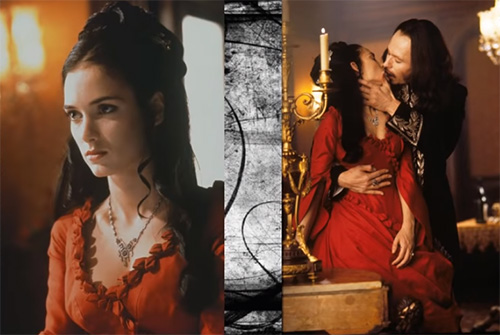
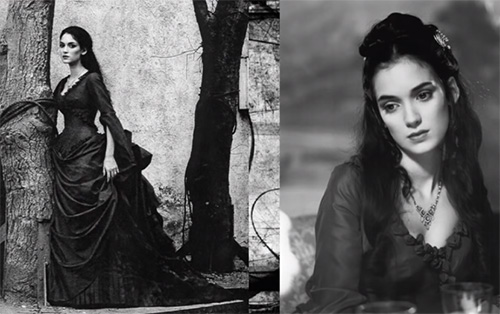
Here is a picture of the crinoline worn under the gown, a heavily flounce petticoat, and rear caging supporting the bustle and the weight of the overgown. All of this is important for a perfect silhouette.
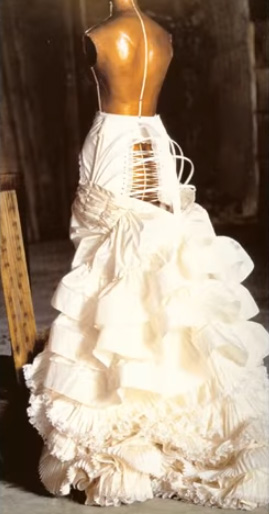
As soon as Mina leaves London and Dracula, her fashions return to the modest Victorian-style costumes.
We see very little of Mina's ribbed silk wedding gown when she marries Jonathan Harker. It's important to note that while Queen Victoria popularized the white wedding gown in England for elite brides, the middle class didn't adopt this trend fully until after World War II.
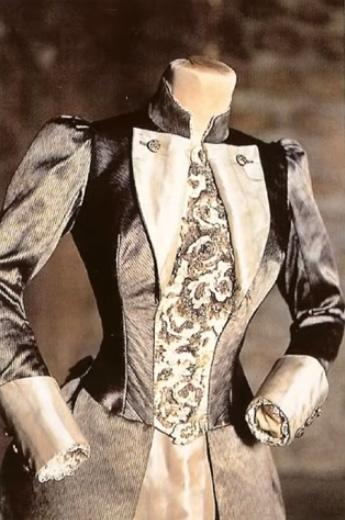
Mina does wear the veil during her ceremony, a requirement in most churches for women back in the 19th century. One of the best features of the gown, of course, is this wonderful ruffle detail at the back.
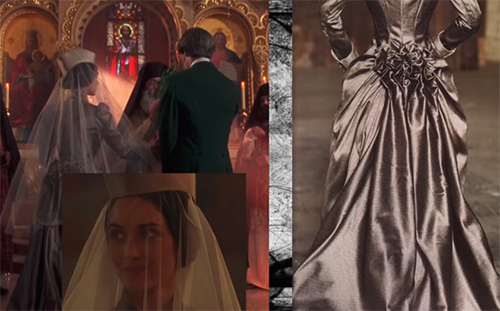
This is one of the best costumes for Mina. This forest-green silk velvet gown with contrasting lime-green lining. It looks similar to a medieval outer garment with its long hanging sleeves and stand-up collar. The gown has a deep V-neckline, from which Mina claws while she's under the spell of Dracula's brides.
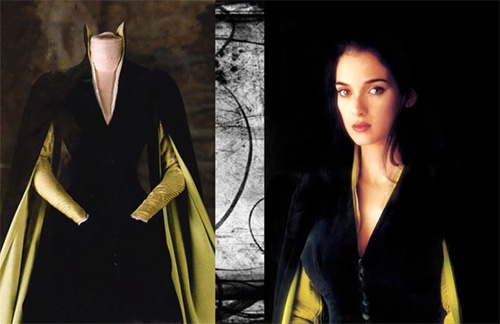
It also resembles this fantastic green and gold velvet robe worn by Vivien Leigh in “Gone with the Wind”, designed by Walter Plunkett.
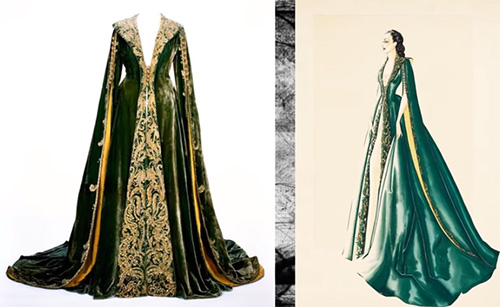
(c)


